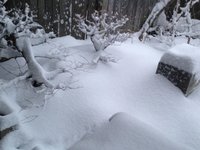Gosh, there are always so many opinions on the granular level about protecting bonsai in winter weather. Just about everyone of these granular opinions are area specific and totally correct for their area. But as on can see each area has its own nuances.
1. Mulch trees in.
2. Protect from sun
& wind
3. Ensure proper drainage
4. Water just before and after cold snaps
5. protect from rodents (there’s frequently a litany from folks on BN in spring who forgot this part.
Recommended locations include in garden beds next to home, window wells…(
@kale brought this forwards years ago), under small tree large shrubs etc….
Given you have shohin here’s a quick, relatively cheap cold frame project idea for shohin. See image below of two example frames.

Materials: 8 PVC corners, PVC to match of length(s) needed, PVC glue, stakes, a hack saw, and a type of covering (shown is a type of greenhouse vinyl). Metal window screen optional.
a. Cut to desired size.
b. Glue together
c. Install covering, zip tie or other fastening. Ensure one side or, better still, the top. Ensure either opening can be easily opened to vent and be secured.
d. Stake down securely out of sun, wind.
e. Put in shohins, assuring proper drainage, mulch in.
For extra varmint protection: metal window screen can be fashioned around or inside and under cold frame, use aluminum wire for joins.
Close when temperatures are below 42 F.
Cheers
DSD sends


